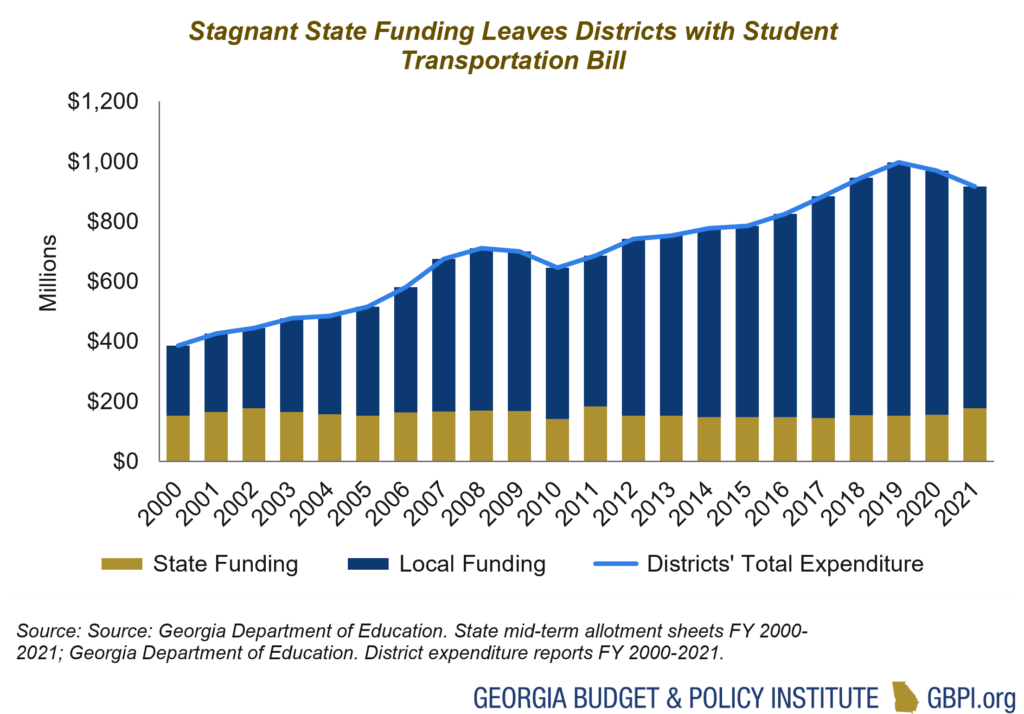Five Georgia senators will meet over the next few months to review education funding mechanisms as a part of Senate Resolution 650. The Quality Basic Education Act (QBE) determines the bulk of state funding for public schools and has undergone few changes since its enactment in 1985. What follows are three ways lawmakers can update the formula to make sure that all children have the resources they need to succeed. These policies will support all Georgians but particularly communities that have been historically kept from the state’s wealth—people of color and communities in poverty.
- Create an opportunity weight for students in poverty
- Raise state investment in pupil transportation
- Increase school counselor funding
Create an Opportunity Weight for Students in Poverty
Georgia is one of only six states that does not provide funding to educate students living in poverty. Recently Georgia ranked 49th out of all states and the District of Columbia based on the difference between how low-income students do on state tests compared to their higher-income peers. Gov. Deal’s 2015 Education Reform Commission recommended adding a weight to the way the state funds education to support these children, stating: “It has been demonstrated that many economically disadvantaged students enter Kindergarten at an academic level far below their peers. However, when a student enters a Georgia school…[their]…background, situation and circumstances should never predetermine how much, or how little…[they]… progress…”
Poverty and race in Georgia are tightly connected by years of white supremacist policies. Increasing funding for students in poverty would support students of every race while disproportionately helping Black and Brown Georgians. This type of policy can help ensure that all schools have the resources they need to educate to the Georgia Standards of Excellence.
While schools do have federal Title I money, policymakers on both sides of the aisle recognize that those dollars are insufficient and limited by mandates and bureaucracy. A state opportunity weight can allow schools to meet the unique educational needs of students in their district. Schools in rural Georgia might need the funds to transport students to dual enrollment programs, those in suburban districts could instead pay for universal free meals, and urban districts could set up wraparound services for students after school, for example.
Raise State Investment in Pupil Transportation
State lawmakers have made significant investments into pupil transportation the last two years—$221 million additional in the amended fiscal year (AFY) 2022 budget, $40 million in the AFY 2021—but these have come as amendments to the previous years’ budgets to finance bus replacement and not formula increases.[1] Schools need state funding that adjusts to the real costs of transporting students, something the formula has failed to do since FY 2000. The graph below shows the impact of growing student enrollment and increased cost of labor, fuel and equipment compared to stagnant state funding.

In the wake of the Great Recession, state policymakers shifted the responsibility for paying health insurance costs for non-teaching staff (e.g., bus drivers and monitors) from the state to local school districts. This decreased further state education spending, leaving districts to cover the cost. This change paired with stagnant formula funding leaves districts without a strong property tax base with fewer options to ensure student safety on buses. Community wealth cannot continue to dictate school resources. Lawmakers need to adjust the formula to recognize real-world costs of this necessary school function.
Increase School Counselor Funding
The American School Counselors Association recommends a school counselor ratio of 1:250; Georgia’s education formula sets a baseline of 1 counselor to every 450 students. In practice, the most recent data available shows that Georgia schools employ a counselor for every 422 students, a number that puts us behind neighbors such as Alabama (1:380) and South Carolina (1:338).[2] At such a high ratio, schools do not have the professionals necessary to address students’ socio-emotional needs. Various studies have highlighted positive effects of hiring additional school counselors with, among others, English-language learners, rural students, low-income students and children exhibiting aggressive behavior or actions associated with depression. Higher numbers of student counselors per school are associated with lower absenteeism, fewer suspensions and higher graduation rates. This intervention is cost-effective as well; the effects of school counselors on student behavior and academic outcomes are financially efficient compared to alternative education policies with similar effects. Georgia’s leaders should prioritize mental health by lowering the ratio of students to counselors in the QBE formula.
Endnotes
[1] Based on a GBPI analysis of HB 80 (AFY 2021 appropriations bill) and HB 910 (AFY 2022 appropriations bill).
[2] Based on a GBPI analysis of Urban Institute education data explorer. https://educationdata.urban.org/data-explorer/explorer



